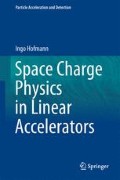Abstract
Particle motion in accelerators is usually assumed in 6D phase space, under the action of external forces for acceleration and focusing, and with space charge interaction resulting from the Coulomb interaction between particles. The by far dominating contribution to direct Coulomb interaction in accelerator beams is via the so-called mean field or self-consistent space charge potential, which is calculated from an assumed smoothed charge density n(x, y, z, t), and ignoring the discreteness of charges. Assuming that collisional effects can be neglected, this chapter introduces the Vlasov-Poisson equations and the important concepts of emittance, rms equivalence as well as beam anisotropy. In the context of computer simulation, however, some aspects of artificial collision and noise effects due to numerical discretisation are an important subject, which is also briefly discussed.
Access this chapter
Tax calculation will be finalised at checkout
Purchases are for personal use only
Notes
- 1.
Collision effects by elastic small angle scattering are ignorable in linear accelerators, but not always in circular accelerators. In the latter the “intrabeam scattering” is an important subject on long time scales as in storage rings or colliders, but it has no direct influence on space charge effects and is thus beyond the scope of this book.
- 2.
Here and in the following it is assumed that the motion in the external focusing optics is first-order and in paraxial ray approximation (see also in [2])
- 3.
The assumption of “infinite phase space resolution” is a hypothetical one; phase space resolution is always limited – ultimately by quantum mechanics –, which is the basis of entropy growth in a real system in the absence of collisions – see also [6].
- 4.
Note that the factor 4, which is used to make this definition stand for the full area (divided by π) of a uniformly populated ellipse, is dropped in some purely rms based conventions.
- 5.
In the remainder of this book the suffix “rms” is omitted, and ɛ is understood as rms emittance, unless otherwise explained.
- 6.
See, for example, the work by Birdsall and Langdon in [8].
- 7.
Therein Struckmeier extends significantly the second order procedure by Sacherer in [12], which is limited to the collision-less Vlasov equation.
- 8.
β f follows from the friction term in Eq. 2.5; note that in or near equilibrium the friction and diffusion terms in this equation are related to each other via the Einstein relations.
References
A.A. Vlasov, J. Phys. USSR 9, 25 (1945)
M. Reiser, Theory and Design of Charged Particle Beams, 2nd edn. (Wiley, Weinheim, 2008)
T.P. Wangler, RF Linear Accelerators, 2nd edn. (Wiley, New York, 2008)
H. Wiedemann, Particle Accelerator Physics Part III (Springer, Berlin/Heidelberg, 2007), p. 335ff
J. Struckmeier, Part. Accel. 45, 229 (1994); also Phys. Rev. E 54, 830 (1996) and Phys. Rev. ST Accel. Beams 3, 034202 (2000)
I. Hofmann, O. Boine-Frankenheim, Phys. Rev. ST Accel. Beams 17, 124201 (2014)
S.M. Lund, R.C. Davidson, Phys. Plasmas 5, 3028 (1998)
A.B. Langdon, C.K. Birdsall, Phys. Fluids 13, 2115 (1970) and C.K. Birdsall, A.B. Langdon, Plasma Physics Via Computer Simulation (IOP Publishing, Philadelphia, 1991)
J.D. Lawson, P.M. Lapostolle, R.L. Gluckstern, Part. Accel. 5, 61–65 (1973)
J. Struckmeier, Phys. Rev. E 54, 830 (1996)
J. Struckmeier, Phys. Rev. ST Accel. Beams 6, 034202 (2000)
F.J. Sacherer, Ph.D. thesis, University of California at Berkeley [UCRL-18454, 1968]
O. Boine-Frankenheim, I. Hofmann, J. Struckmeier, S. Appel, Nucl. Inst. Methods Phys. Res. A 770, 164 (2015)
D. Uriot, N. Pichoff, paper MOPWA008, in Proceedings of IPAC2015, Richmond, 2015
Author information
Authors and Affiliations
Rights and permissions
Copyright information
© 2017 The Author(s)
About this chapter
Cite this chapter
Hofmann, I. (2017). Phase Space Dynamics in Theory and Simulation. In: Space Charge Physics for Particle Accelerators. Particle Acceleration and Detection. Springer, Cham. https://doi.org/10.1007/978-3-319-62157-9_2
Download citation
DOI: https://doi.org/10.1007/978-3-319-62157-9_2
Published:
Publisher Name: Springer, Cham
Print ISBN: 978-3-319-62156-2
Online ISBN: 978-3-319-62157-9
eBook Packages: Physics and AstronomyPhysics and Astronomy (R0)

